Guide to Ethernet Network Cables
What is an Ethernet Cable?
An ethernet cable is a network cable that is used to connect data communication equipment like routers, modems or network switches to equipment that needs to
connect to the local area network (LAN), like computers, phones, and printers. Data communication over ethernet cables follows the ANSI/TIA-568 standard developed by the
Telecommunications Industry Association (TIA) and the Electronic Industries Alliance (EIA).
ANSI/TIA 568A, published in 1995, and
ANSI/TIA 568B, published in 2001,
define two different options for pinouts and wire pairs for ethernet cabling.
Ethernet Cable Structure
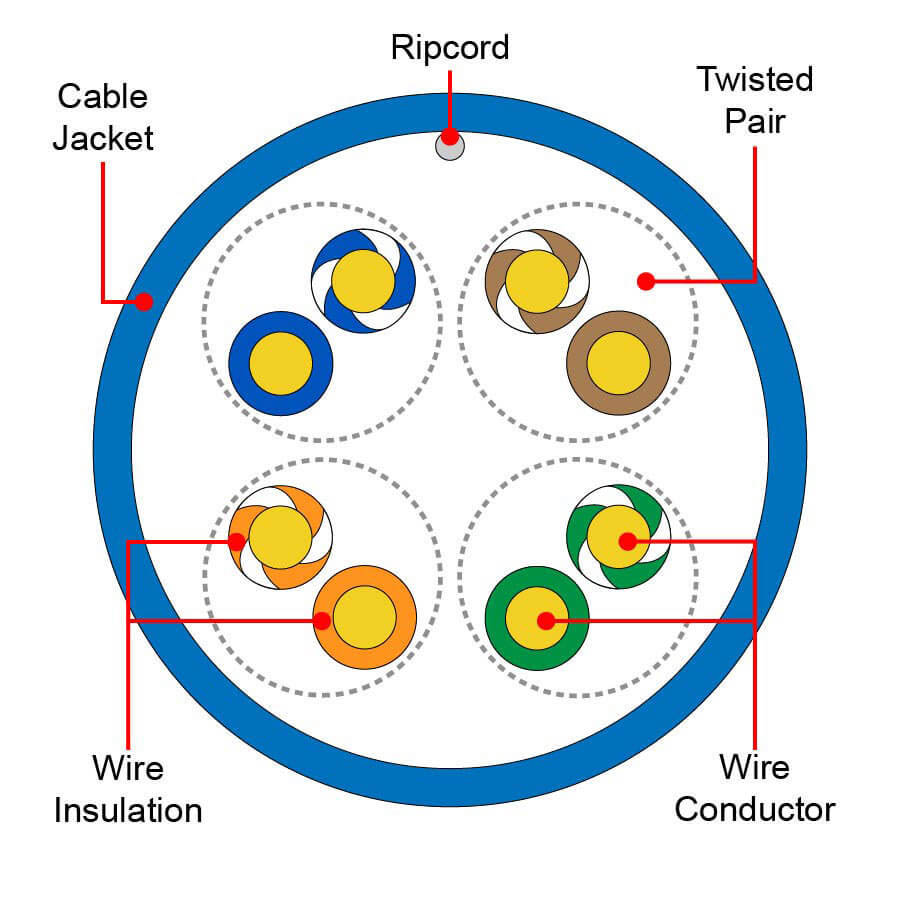
Ethernet cables contain 4 twisted wire pairs for a total of 8 insulted copper wires with an outer layer of protection called a cable jacket.
The cable jacket, often made of PVC, protects the enclosed wires from physical and chemical damage. The cable may also have a ripcord. An ethernet cable ripcord is a
yarn, like nylon or polyester, underneath the jacket of an ethernet cable that is used by an electrician to peel back the jacket of the
ethernet cable without damaging the twisted pair wires. When the electrician pulls the ripcord,
the ripcord cuts the ethernet cable jacket.
See our next
Ethernet Cable Shielding
section for details about shielding options for ethernet cables and drain wire for shielded cables.
What is a Twisted Pair?
A twisted pair is a set of two insulated copper wires that are twisted around each other to reduce noise.
How Does Twisting Pairs of Wires Reduce Noise?
In copper cables, a signal from one wire may
cause noise in another wire that is nearby through the electromagnetic radiation of the wire. Twisting of the wires reduces noise in the signal in two ways:
-
With twisted wires, as one wire moves closer to the interference, the other wire in
the pair moves away. When the signal is reconstructed at the receiving device,
combining the signal from the two wires with equal current but opposite
(180° shifted) phase, the result is less noise.
-
The twisted pair is also called a balanced twisted pair. Every twist of the pairs reverses the polarity of electromagnetic radiation, resulting in
electromagnetic balance, which has the effect of canceling out much of the electromagnetic radiation. Tighter twisting results in less electromagnetic
interference (EMI) in adjacent wires.
Ethernet Cable Shielding
ISO/IEC 11801 Shielding Naming Convention
Since ethernet cables are susceptible to electromagnetic interference (EMI) noise between wires within the cable and from other nearby electronic devices, many
cables have shielding to block
electromagnetic noise. There are two categories of shielding used in ethernet cables: cable shielding and twisted pair conductor shielding.
Cable Shielding
Cable Shielding refers to an outer protective layer of shielding that wraps the entire cable assembly of twisted pairs. This outer layer of cable shielding reduces noise from other
nearby electrical devices and reduces EMI noise radiated from this cable. There are four common ethernet cable shield types:
- U - Unshielded
- F - Foil Shielded
- S - Braided Shielding
- SF - Foil and Braided Shielding
Twisted Pair Conductor Shielding
Twist Pair Conductor Shielding refers to a protective layer around a twisted pair of wires to reduce noise. This shielding on wire pairs is especially helpful in reducing
crosstalk. Crosstalk
is noise caused by electromagnetic radiation from other wires in the cable. There are three common types of twisted pair conductor shielding in ethernet cables:
- UTP Cable - Unshielded Twisted Pair
- FTP Cable - Foil Twisted Pair
- STP Cable - Braided Shielded Twisted Pair
Naming Conventions for Cable Shielding
Ethernet cable shielding is designated by the ISO/IEC 11801 Shielding Naming Convention: XX/YYY, where XX designates the
cable shielding, and YYY designates the shielding of the twisted pairs.
U/UTP Cable
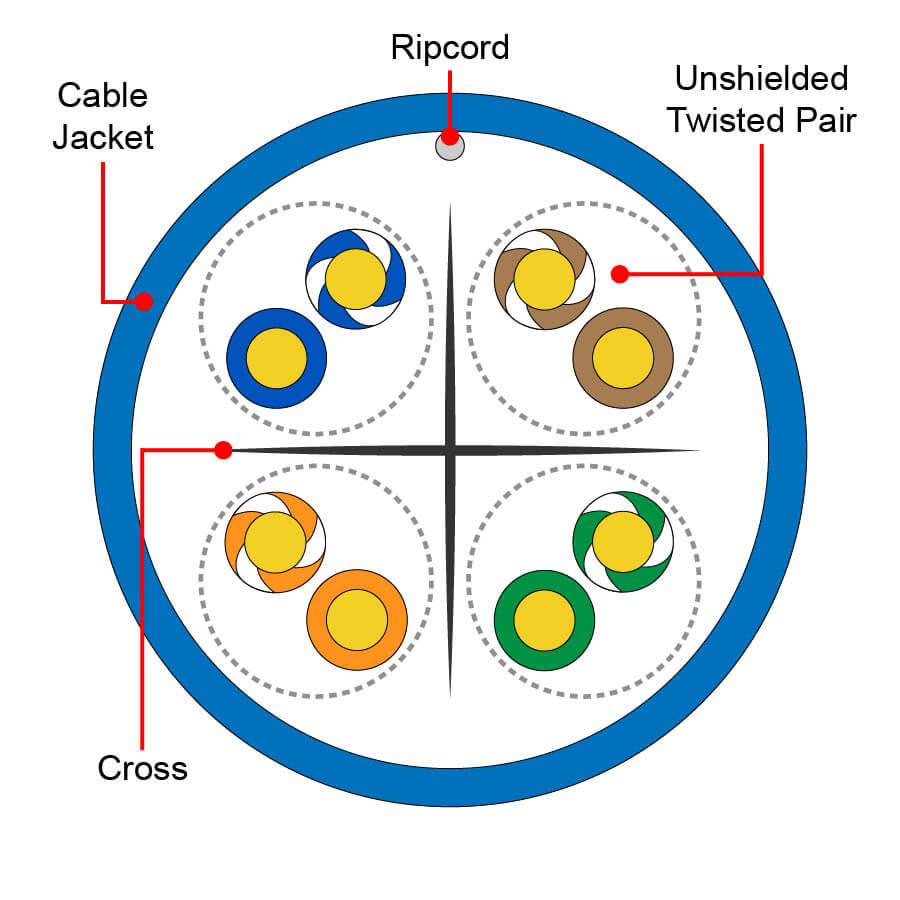
U/UTP cable is commonly called UTP cable. This cable has no shielding on the twisted pair or the cable.
F/UTP Cable
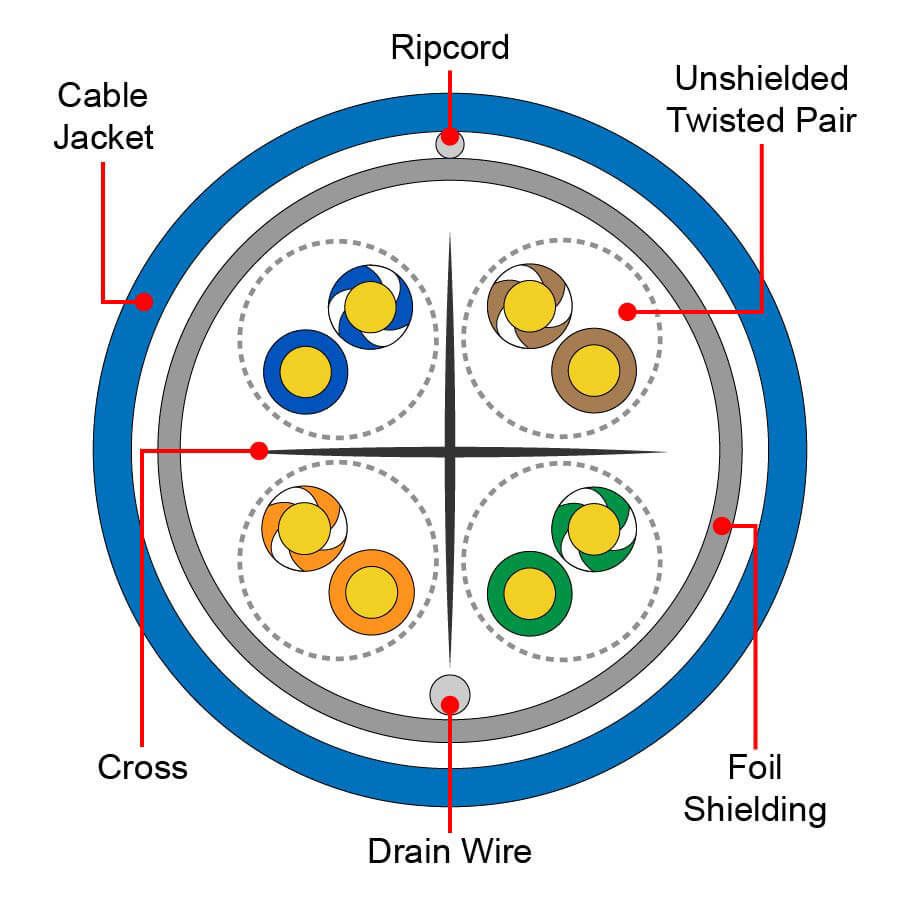
F/UTP Cable, commonly called either FTP or STP cable, has no shielding around each twisted pair but has outer foil shield under the cable jacket.
S/UTP Cable
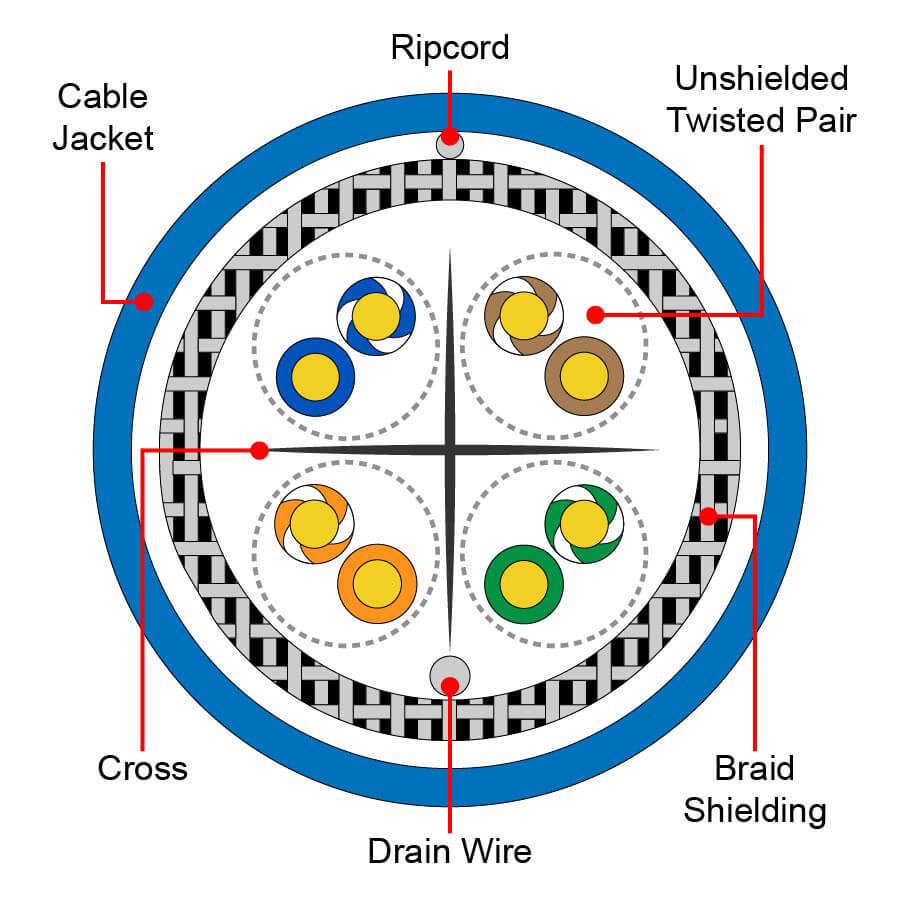
S/UTP cable, commonly called STP cable, has no shielding around each twisted pair but has an outer braided shield under the cable jacket.
SF/UTP Cable
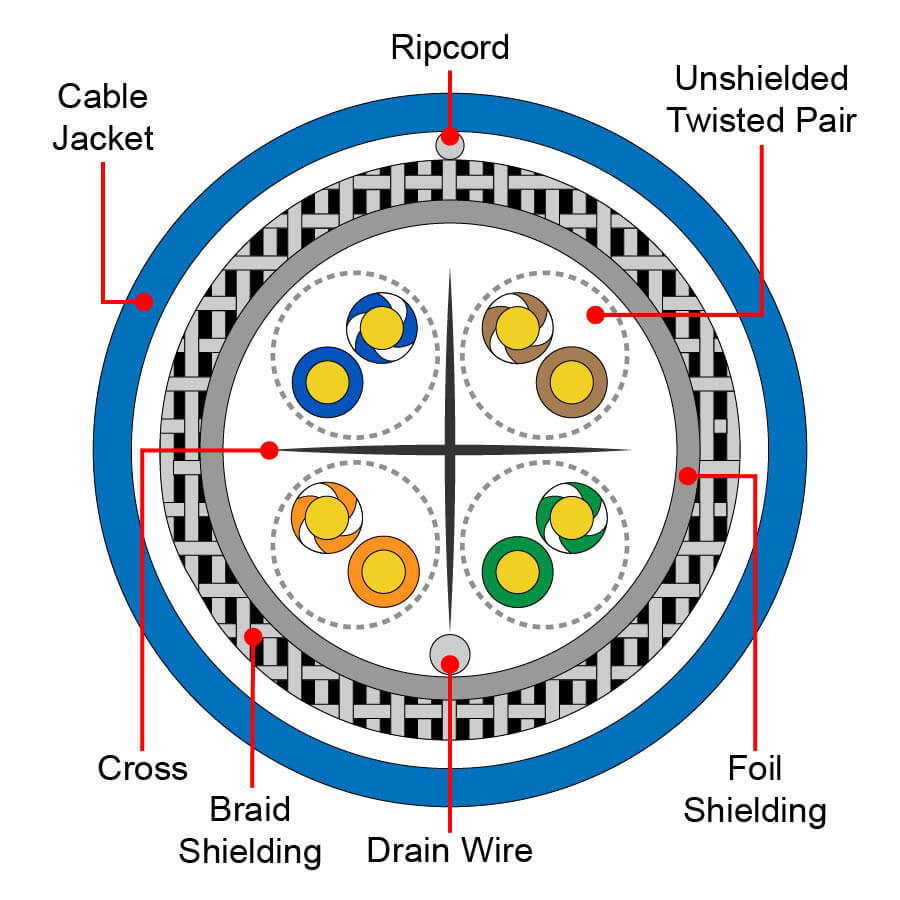
SF/UTP Cable, commonly called either SFTP or STP cable, has no shielding around each twisted pair but has an outer braiding and foil shields under the cable jacket.
U/FTP Cable
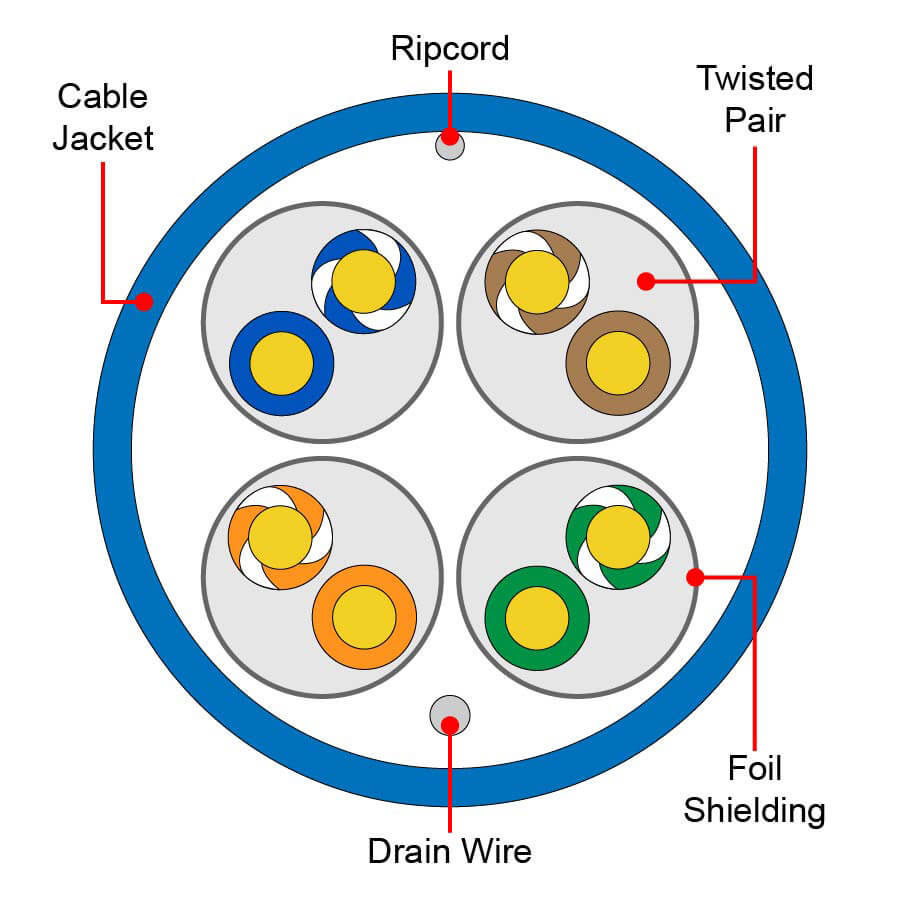
U/FTP Cable, commonly called STP cable, has foil shielding around each twisted pair but has no outer shielding under the cable jacket.
F/FTP Cable
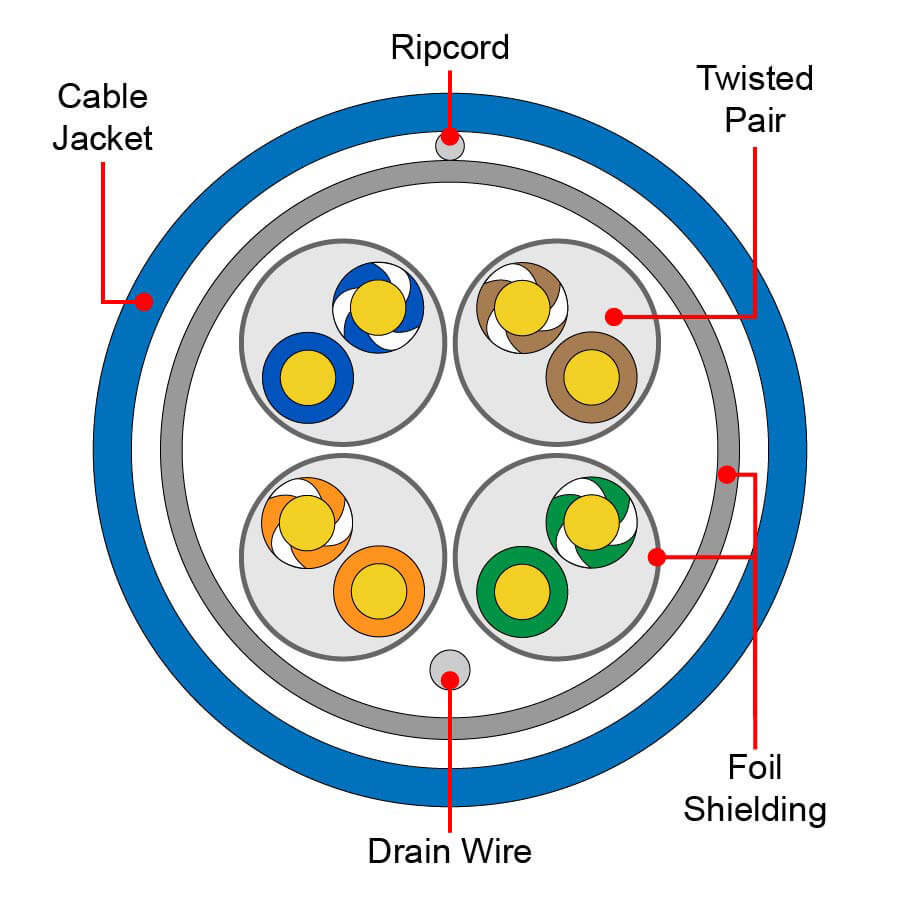
F/FTP Cable, commonly called FFTP cable, has foil-shielded twisted pairs that are wrapped in an outer braided shielding just under the cable jacket.
S/FTP Cable
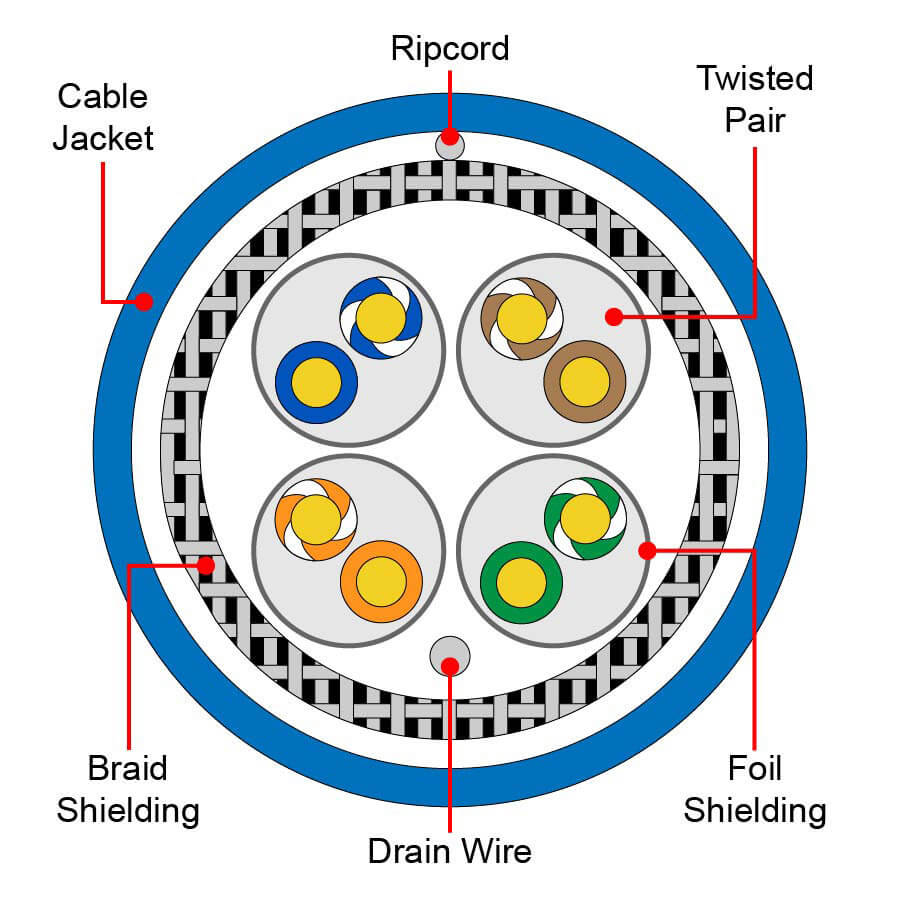
S/FTP Cable, commonly called SFTP cable, has foil shielding around each twisted pair and has outer braided shielding under the cable jacket.
SF/FTP Cable
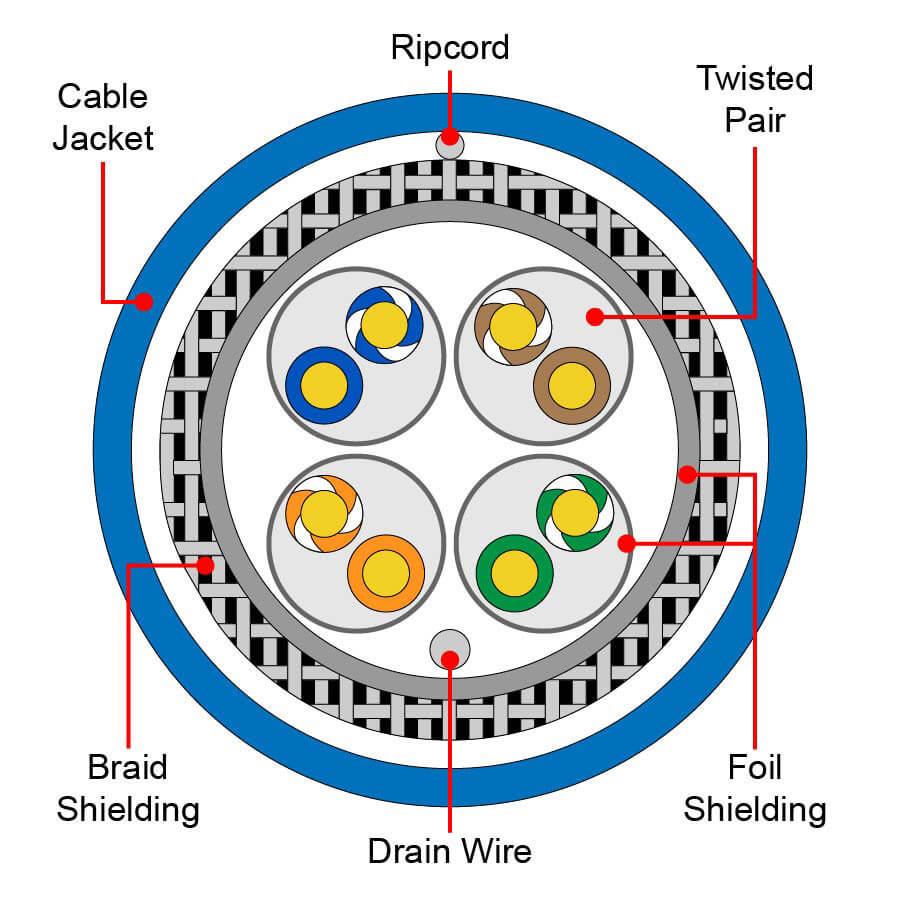
SF/FTP Cable, commonly called SFTP or SSTP cable, has foil shielding around each twisted pair and has both outer braided shielding and foil shielding under the
cable jacket.
S/STP Cable
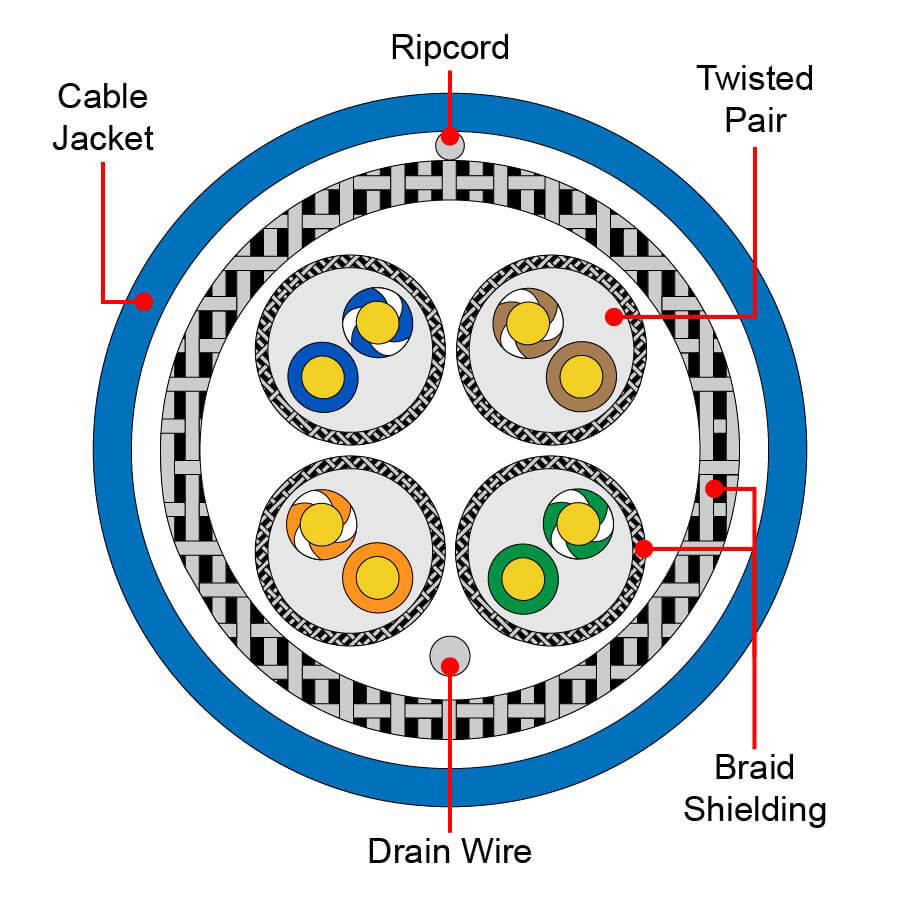
S/STP Cable, commonly called SSTP cable, has braided shielding around each twisted pair and has an outer braided shielding under the cable jacket.
What is an Ethernet Cable Drain Wire?
An ethernet cable drain wire in a shielded ethernet cable is a bare wire connected to the metal shielding of the cable. To ground the
shielded ethernet cable, electrians connect the drain wire to ground. This grounding of the drain wire will allow excess current in the ethernet cable to be safely
transferred to ground instead of allowing the excess current to damage equipment connected to the ethernet.
Comparison of Ethernet Category (CAT) Cable Types
Cable Distance, Frequency, Shielding, and Applications
The Category Rating System was developed by the Telecommunications Industry Association (TIA) as a response to the industry's request for higher data rate
specifications on applications over unshielded (UTP) and shielded twisted pairs (STP). This rating system has been integrated into the body of the ANSI/TIA-568-D published
in 2015, which supersedes both
EIA/TIA-568B
and
EIA/TIA-568A
standard documents.
The category rating system only applies to 100 ohm Unshielded Twisted Pair (UTP) and Shielded Twisted Pair (STP) wiring systems.
Cat 3 Cable - UTP
Category 3 Unshielded Twisted Pair Cables
Cat 3 is characterized to 16 MHz and supports applications up to 10 Mbps. Cat3 applications may range from voice to 10BaseT Ethernet networks. While Cat 3 was
included in the Power over Ethernet standard, it is not included in the later PoE+ standard that allows higher Watts. Cat 3 cables are being replaced with newer cables.
Cat 4 Cable - UTP
Category 4 Unshielded Twisted Pair Cables
Cat 4 is characterized to 20 MHz and supports applications up to 10 Mbps. Cat4 applications may range from voice, 10BaseT Ethernet, and IBM Token Ring networks.
Cat 4 is a legacy cabling standard included in
EIA/TIA-568B, but is not included in the ANSI/TIA-568D standard.
Cat 5 Cable - UTP
Category 5 Unshielded Twisted Pair Cables
Cat 5 is characterized to 100 MHz and supports applications up to 100 Mbps for cable lengths shorter than 100m. Cat5 applications may range from voice to TP-PMD.
Cat 5 uses are standard 10BaseT,
100BaseT networks, video, and telephones. Cat 5 Cable is a legacy cabling standard that was included in
EIA/TIA-568B, but is not included in the ANSI/TIA-568D standard.
CAT 5e Cable - UTP
Enhanced Category 5 Unshielded Twisted Pair Cables
Many manufacturers create a special enhanced version of the cat 5 cable called cat 5e with
tighter twisting on the twisted pairs to reduce crosstalk and allow applications of up to 1 Gbps. Cat5e provides an additional NEXT margin
(sometimes referred to as headroom)
over the specified frequency band from 1 MHz to 100 MHz. The total noise power with all pairs energized (usually specified as Power Sum NEXT) meets or exceeds the
Category 5 specification for worst pair-to-pair NEXT (Near End Crosstalk). It also provides improved ELFEXT (Equal Level Far End Crosstalk) and Return Loss (RL)
Performance compared to Cat 5 cable.
Cat 6 Cable - STP or UTP
Category 6 Shielded or Unshielded Twisted Pair Cables
Cat 6 is characterized to 250 MHz and supports applications up to 1 Gbps. At shorter distances of up to 37 meters (121 feet), Cat 6 can achieve 10 Gbps speeds.
Cat6 applications range from gigabit Ethernet to commercial buildings. The Cat 6 cable is backward compatible with Cat 3, Cat 5, and Cat 5e cable. Cat6 cable has
less crosstalk and Electromagnetic Interference (EMI) noise compared to CAT5e cable.
CAT 6a Cable - STP
Augmented Category 6 Shielded Twisted Pair Cables
Cat 6a is characterized to 500 MHz and supports applications up to 10,000 Mbps. Compared to Cat 6 cables, Cat 6a cables can support twice the bandwidth and are capable
of sustaining higher transmission
speeds over longer cable lengths. However, Cat 6a is less flexible than Cat 6. Cat6a applications range from gigabit Ethernet in data centers to commercial buildings.
Cat 7 Cable - STP
Category 7 Shielded Twisted Pair Cables
This is an informal number for ISO/IEC 11801 Class F cabling, not endorsed by IEEE or TIA/EIA. Cat 7 is characterized to 600 MHz and supports applications up to
10,000 Mbps.
To use, application transmissions of frequencies 1 - 600 Mbps are required. Application is good for 10 Gbps core infrastructure or high electromagnetic radiation areas like
medical imaging facilities, because of this cable's improved noise resistance compared to CAT6.
Cat7a Cable - STP
Augmented Category 7 Shielded Twisted Pair Cables
Cat 7a delivers 10 Gb/s performance and beyond, offers a bandwidth of 1.2 GHz per pair, supports cable sharing, and is validated for
TEMPEST high-security government
applications. Cat7a exceeds 10GBASE-T requirements. It also supports up to 100 meters (328.08 feet).
Cat 8 Cable - STP
Category 8 Shielded Twisted Pair Cables
Cat 8 is characterized to 2,000 MHz. Cat 8 supports 10,000 Mbps; and 40,000 Mbps up to 30 meters (98 feet). Cat8 cables are ideal for switch-to-switch communications with
25GBase T or 40GBase T networks. This decreases power consumption and is intended for bandwidth-intensive data center applications. Cat8 cables use standard RJ45
connectors and are backward compatible.
Ethernet Cable Wire Colors and RJ45 Connector Pinout
Ethernet cables contain 4 twisted wire pairs for a total of 8 insulated copper wires. Each twisted wire pair has one solid-colored wire and one white-striped wire of the same color.
Each ethernet wire pair uses a distinct color that designates the wire pair: green, orange, blue, and brown. Ethernet cable wires are
typically connected to an RJ45 male connector on each end of the cable. RJ45 male connectors are modular plug-in components. Two wiring standards, EIA/TIA T568A and T568B, designate
how to terminate the ethernet cable wires in an 8-pin RJ45 modular connector.
T568A Wiring Diagram
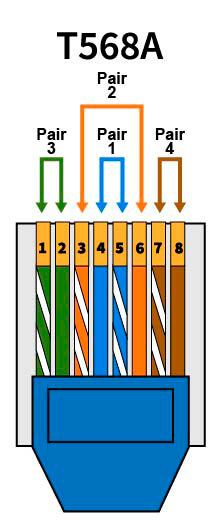
T568B Wiring Diagram
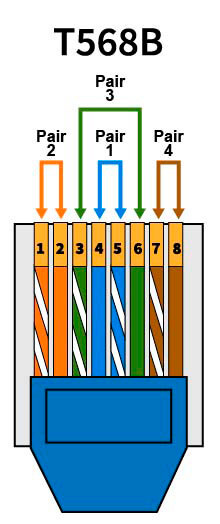
What's the difference between the EIA/TIA T568A and T568B Wiring Standards?
T568A is different from T568B in that pairs 2 and 3 (green and orange) are switched in the connector pin assignments. Pin 1 and 2 are green in a T568A cable, but are orange in a T568B
cable. Pins 3 and 6 are orange in a T568A cable but are green in a T568B cable. EIA/TIA T568A is a wiring standard often used in residential
networks or horizontal cables, and is backward compatible with older telephone wire, whereas the newer EIA/TIA T568B wiring scheme is typically chosen for commercial
networks because it provides better noise protection for more recent networking systems.
Straight Through Cable vs. Crossover Cable
A straight-through ethernet cable connects devices of different types, like connecting a router to a computer
or connecting a network switch to a computer. A crossover cable is used to connect two devices of the same type, like connecting a computer to a computer or connecting a
switch to a switch. A typical crossover cable differs from a straight-through cable in that the transmit and receive (green and orange) pairs are swapped, connecting the
transmit pins of one connector to the receiving pins on the other connector. In some crossover cables, additional wire pairs are also crossed.
Ethernet Straight-Through Cable Wiring
Most ethernet wiring applications use a straight-through cable. When a computer is connected to a router or switch, the transmit and
receive pairs are swapped internally to the router or network switch, so the cable itself can transmit the signals straight through. A straight-through ethernet cable has
identical connector wiring on both ends of the cable.
Straight-through cables have either an EIA/TIA-568A connector at both ends or an EIA/TIA-568B connector at both ends.
Ethernet Crossover Cable Wiring
An Ethernet crossover cable allows devices of like types to be connected directly to each other, by switching the transmit pair with the receive pair within the cable.
Ethernet crossover cables are rarely used now, since the introduction of the automatic crossover (auto MDI-X) feature in the 1000BASE-T standard. Devices with the automatic
crossover feature can
auto-detect the transmit and receive pair of the cables and adjust accordingly, eliminating the need for an ethernet crossover cable.
Half Crossed (2 Pair) Crossover Cable Wiring
The most common type of Ethernet crossover cable is a half-crossed cable in which only the transmit pair and the receive pair (orange pair and green pair) are swapped.
The order
of wires within each pair is not swapped. A 2-pair crossover cable has a T568A connector at one end and a T568B connector at the other end. This allows devices of the
same type, like two computers, which do not have the automatic crossover feature to be connected. Power over Ethernet (PoE) devices can use half-crossed (two pair)
crossover cables, but not four pair crossover cables. Half crossed 2 pair crossover cables
are used for 10BASE-T or 100BASE-TX.
Fully Crossed (4 Pair) Crossover Cable Wiring for T568A and T568B
Fully crossed ethernet crossover cables have all four pairs crossed. The orange pair and the green pair are swapped, and the blue pair and the brown pair are also swapped.
Fully crossed crossover cables are used for 1G, 10M, and 100M ethernet.
Explanation of Telecommunication Network Cable Colors for Cat Cables
Each category cable (CAT3, CAT5, CAT5e, CAT6, CAT7, and CAT8) comes in a variety of different cable jacket colors. Ethernet cable jacket colors are used to differentiate the
function of the category cable within your telecommunications network. The color of the jacket does not indicate any change in the specifications of the category cable.
What ethernet cable color do you need for your networking project? Although you can choose any color coding system for your telecommunication network as long you are
consistent with your color usage, technicians often choose an ethernet cable color based on the function of the network cable recommended by ANSI/TIA/EIA-606 in the chart below.
Standard List of Cable Jacket Colors and Functions
for ANSI/TIA/EIA-606 Network Cabling
(The Cabling Administration)
| Cable Color |
Cable Function |

Gray |
Second-level backbone |

Green |
Network connections and auxiliary circuits |

Orange |
Demarcation point, telephone cable from Central Office |

Purple |
First-level backbone |

Red |
Key-type telephone systems |

Silver or White |
Horizontal data cables, computer & PBX equipment |

Yellow |
Auxiliary, maintenance & security alarms |
Browse Our Ethernet Cables, Accessories, and Tools
See Our Other Helpful Cable Guides:
Warning: When using this information to perform electrical work, call a licensed electrician and consult the NEC® Communication Systems Chapter 8
and ANSI/TIA‑568‑A, ANSI/TIA‑568‑B, and ANSI/TIA‑568‑D for safety.
All licensed electricians have passed examinations covering the National Electric Code®, know state and
local building codes, and may carry insurance to cover damages.